top officers, and ministers
italiano
This page, like the others, is a work in progress.
We would appreciate more data to fill it.
Please send data, photos and sources to
Acosta, Jorge Eduardo. (Navy Captain)
- Alias "El Tigre" (the tiger).
Chief of the Intelligence Task Force Navy unit GT-332
based at the ESMA (Navy Mechanics School) on Avenida Libertador
in Buenos Aires. Responsible, with his colleagues
(Rear-Admiral Rubén Jacinto Chamorro,
Captain Francis Whamond, Luit. Enrique Yon, Luit. García Velazco,
Luit. Antonio Pernias, Luit. Juan Carlos Rolón,
Luit. Roberto González, and others) for about 5000 kidnap and
murder cases, many of them thrown
out alive into the Atlantic ocean from Navy planes.
As the boss of Alfredo Astiz, Acosta is also responsible for giving the orders to kill the Swedish teenage girl Dagmar Hagelin, the French nuns of the Church of Santa Cruz, Leonie Duquet and Alice Domon, and the founder of the Mothers of Plaza de Mayo human rights group, Azucena Villaflor de Vicenti.
Acosta was clearly a psychopath. One minute he could be kissing a wanted prisoner through the man's hood, overjoyed at seeing him on the torture table of the ESMA, the next minute twisting the dial on the electric shock machine higher and higher, his face contorted with concentration. [Children of Cain, p. 93]
Acosta's credibility evaporated as he began his testimony before a civilian court in December 1986; "I have no knowledge that there were prisoners in the Mechanics School", he said. In another time he added: "There were no detentions as such. It was like someone goes to a police commission and they're asked, 'Is this what you did?' If he said he did nothing ... he could leave."As of March 1996, Acosta works for the federal government at the ministry of the interior in Buenos Aires, in which archives, incidentally, all the testimonies given before the CONADEP are kept out of the reach of the general public.
In October 2011, Acosta was sentenced to life in prison by an Argentine court [source: Clarin (in Spanish)]
Agosti, Orlando Ramón. (Brig. Gen.)
- Commander of the Air Force. Member of the leading triumvirate
(Videla,
Massera, Agosti) that
seized power in Argentina on March 24th, 1976.
After democracy was restored, Agosti was sentenced to 4 1/2 years
in jail for his part in the repression era. Set free by President
Carlos Menem before serving his full sentence as a result of
military pressure.
Anaya, Jorge I. (Adm.)
- Commander of the Navy after Lambruschini in the third (Galtieri's) Junta. Main planner of the Falklands-war invasion. Acquitted in the post repression 1985 trial.
- [From the testimony of Silvia Labayru, File No. 6838]:
 "Alias 'Angel', 'El Rubio', 'Blondie', 'Crow', or 'Eduardo Escudero', then
a navy lieutenant, had some experience of infiltrating human rights
organizations. Possibly this is why he was entrusted with this
particular duty at the end of 1977. Between October and November
1977, under the name Gustavo Niño, Astiz began to attend the masses,
public actions and meetings being organized at the time by the families
of the disappeared. He posed as a brother of a real missing person..."
"Alias 'Angel', 'El Rubio', 'Blondie', 'Crow', or 'Eduardo Escudero', then
a navy lieutenant, had some experience of infiltrating human rights
organizations. Possibly this is why he was entrusted with this
particular duty at the end of 1977. Between October and November
1977, under the name Gustavo Niño, Astiz began to attend the masses,
public actions and meetings being organized at the time by the families
of the disappeared. He posed as a brother of a real missing person...""The fourth and last time, when I went with him to a private home in the La Boca district, it had been decided in advance that the people in the meeting would be kidnapped. This was one of the five operations which were to be carried out between the 8th and 10th of December. The other four were: the abduction of a group meeting in Santa Cruz church; the abduction of people gathering at an established meeting place in a bar on the corner of Ave. Belgrano and Paseo Colon; the subsequent kidnapping of Azucena Villaflor de Vicenti, founder of the Mothers of Plaza de Mayo group, as she was leaving her home, and finally the kidnapping of one of the nuns, Leonie Duquet, at the home she shared with Alice Domon, who had previously been abducted in the La Boca district."
 [From Uki Goñi's
Ukinet]:
[From Uki Goñi's
Ukinet]:
Astiz, still baby-faced and in active service at 44 years of age, stood out among the repressors because of his youth, his heart-stopping good looks, his bright shock of silken hair, and his zeal for kidnapping, torturing and murdering defenseless women. Although the Navy credits Astiz with a key role in the fight against subversion, his known list of victims does not include a single proven terrorist. Instead, he can claim the deaths of a 17-year-old Swedish girl [Dagmar Hagelin], whom he shot in the head from behind, two French nuns, aged 40 and 63, four Mothers of Plaza de Mayo in their 50s and three women in their twenties, none of them linked by any court to any terrorist activity.On April 26, 1982, unable to withstand a British attack for more than 24 hours, Astiz surrendered in the South Georgia island to British commandos in the Malvinas/Falklands war. "He was very brave when he had to murder unarmed women, but he surrendered immediately when he had to fight real soldiers," said Nora Cortiñas, another mother who remembers Astiz from when he infiltrated the group.
A book by Uki Goñi: "Judas - El Infiltrado" (in Spanish) tells the full story.
Astiz was held under arrest pending sentence for these crimes in Argentina for five months in 1987, but was finally released under the amnesty laws to those "following orders" by democratic President Raúl Alfonsín. Still he cannot leave Argentina because of Interpol arrest orders for the kidnapping and murder of the two French nuns and the Swedish teenage girl. In 1990, a French court indicted Astiz in his absence to life in prison. Still, in 1995, a promotion was seeked by the Admiral of the Argentine Navy. A massive public protest and and pressure from the French government led to the resignation of Astiz from the Navy by the end of that year.
In October 2011, Astiz was sentenced to life in prison by a new Argentine court [source: Clarin (in Spanish)]
Bayon, Juan M. (Brig.)
- data requested
Bignone, Reynaldo Benito (Gen.)
- On 28th of March 1976, headed a wide operation in the Alejandro
Posadas Hospital in the Haedo district. During this operation
40 people were kidnapped, the rest of the hostpital staff was discharged,
and the place was converted to a secret detention center.
Also served as the head of another secret detention center based
in the military school in Buenos Aires.
One of the testimonies (given by Hugo Ernesto Carballo, file no. 6279) mentions a visit of high ranking officers to where he was detained in which Bignone informed the prisoners that "in a dirty war the innocent paid for the guilty."
Bignone main entry into history will probably be as the main crime cover-up architect. Bignone was already retired when he was requested by the junta to replace Galtieri as president after the defeat of the Argentine Army in the Falklands. On July 1st, 1982, two weeks after Galtieri's resignation, Bignone became the fourth and last president of the de-facto government.
Realizing that the military could not continue to govern as a result of the terrible economic depression, the increasing dissent resulting from the mass disappearances, and the rout in the Falklands war, Bignone gave explicit orders, in a confidential decree no 2726/83 to destroy every documentation related to the detained and disappeared, Then, he proceeded to organize elections to install a democratic and civilian government. Under his leadership, the junta took precautions, before the elections, of adopting a general amnesty purporting to immunize every member of the military from prosecution for any crimes committed in the so called "war against subversion."
Bignone was sentenced to prison on his part in the repression, but was released long before completing his jail period as a result of military pressure.
Bussi, Antonio Domingo. (Maj. Gen.)
- Military governor of Tucuman in 1976 and 1977. Responsible
for directing the torture and disappearance of more than 500 people
in the province. According to several testimonials, Bussi
personally
took part in the killings.
Bussi could serve as the ultimate proof of how short people's memories can be; nearly twenty years after committing crimes against his own people, retired army general Bussi was elected as governor of the province of Tucuman. Argentine writer Ernesto Sabato -- who during the 1980s led the National Commision on the Disappearance of Persons (CONADEP) -- called Bussi's election "a horror," and pointed out that if it wasn't for the "Punto Final" amnesty law, the former general would be in jail.
Camps, Ramón J. (Gen.)
- Chief of the Buenos Aires provincial police under the
Videla junta. Responsible for hundreds of disappearances and
many secret detention centers
over a wide area including COT 1 Martínez, Pozo de Quilmes,
Pozo de Bánfield, Puesto Vasco, Arana, La Cacha, Police station no. 5,
& La Plata detective Squad headquarters.
Personally involved in torturing prisoners as documented in
several files by the National Commission on the disappeared.
In a Feb 11, 1983 interview to James Neilson of the newspaper La Semana, Camps confessed that "no disappeared persons were still alive" and that "no one told the truth so as not to affect international economic aid" (a surprising confession of a top military man) and warned that "the struggle is not over, nor my role in it".
Camps were among those top officers, who were tried and sentenced to prison but released long before completing their jail period as a result of military pressure.
Chamorro, Ruben Jacinto. (Vice Adm.)
- Alias 'Dolphin' or 'Maximo'.
Chief of the Navy Mechanics School (ESMA) in Buenos Aires,
one of the most notorious secret detention centers, as Navy captain.
Was later promoted to Rear Admiral under the Navy commander-in-chief
Emilio Massera.
During his time as Navy Mechanics School commander
Chamorro and his staff were responsible for thousands of tortures,
lootings of detainees homes, and murders. The Navy Mechanics School
came to the headlines in 1995 when retired Navy personnel
who were serving in that base, started a
series of confessions about throwing hundreds of live detainees
from Navy planes into the Atlantic ocean.
Dalla Tea, Carlos A. (Brig.)
- A graduate of the School of the Americas, 1960.
data requested Díaz Bessone, Ramón Genaro (Gen.)
- Appointed minister of planning at the beginning of the dictatorship and throughout most of the repression period.
Etchecolatz, Miguel Osvaldo
-
General Director of Investigations for the Buenos Aires Police
under Ramon Camps. Responsible for
21 Clandestine Detention Camps that functioned in Buenos Aires,
among them the Pozo de Quilmes, COT1 Martínez, and Arana.
Also known for his involvement in the "Night of the Pencils",
an operation that involved the disappearance of several high
school students in one night.
Etchecolatz was convicted in Federal Court of 91 charges of torture, and sentenced to 23 years in prison. However, he was freed through the "Due Obedience" law after serving only a small part of his sentence.
Now serves as vice president of ANIDAR, a fascist group formed by retired military, ex-repressors and neo-nazis.
Galtieri, Leopoldo Fortunato (Gen.)
-
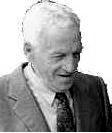 A graduate of the School of the Americas, 1949.
A graduate of the School of the Americas, 1949.
Commander of the 2nd army corps when the first junta took power in 1976. The third president of the de-facto government between Dec 1981 and June 1982.While president, during the worst economic depression in Argentina since the 30's, Galtieri turned to the traditional remedy of unsuccessful tyrants and attempted to divert public attention by ordering the occupation of the Falkland (Malvinas) and South Georgia Islands.
The small group of islands in the south atlantic which Britain has ruled since 1833 and which have long been claimed by Argentina, were invaded on April 2nd 1982 by the Argentine army. As it turned out, Galtieri and his advisors fatally misjudged Great Britain's willingness to defend its territory and citizens. The sudden occupation has led to a brief war and a quick defeat of the Argentine forces.
On June 14th 1982 the Argentine forces in the Falkland islands, led by Gen. Mario Menendez, surrendered unconditionally to the British and the British rule of the islands was restored. The loss of the Falklands war has led to the resignation of Galtieri from presidency on June 17th, 1982. A third (and last) junta was placed in power under a new president, Reynaldo Bignone. Ironically, the occupation of the Falklands, has accelerated the end of the junta rule.
Galtieri was acquitted in the junta trials on charges of committing crimes against the Argentine people, but convicted later, in 1986, on charges of incompetency while leading the army in the Falklands War. He was set free after serving only a small portion of his sentence as a result of military pressure.
"A young woman testified that after she had been held blindfolded and tortured for months she and others in her group were allowed to clean themselves, in preparation for a visit to the detention center by General Galtieri, who was then army commander of the local district. Galtieri asked if she knew who he was, and if she understood his absolute power over her. ``if I say you live, you live, '' he said, ``and if I say you die, you die. As it happens, you have the same Christian name as my daughter, and so you live.'' [Nunca Mas, introduction]
Garcia, Osvaldo J. (Maj. Gen.)
- data requested
Graffigna, Omar D. (Brig. Gen.)
- Commander of the Air force after Agosti. Acquitted in the post repression 1985 trial.
Harguindeguy, Albano Jorge (Gen.)
-
 Appointed minister of the Interior under the junta rule.
Among the most devoted accomplices of the military.
In his post as minister of the interior, Harguindeguy
virtually eliminated the judiciary system filling it with
military key personel, leaving the families of the disappeared
with no way of finding out the fate of their loved ones.
Appointed minister of the Interior under the junta rule.
Among the most devoted accomplices of the military.
In his post as minister of the interior, Harguindeguy
virtually eliminated the judiciary system filling it with
military key personel, leaving the families of the disappeared
with no way of finding out the fate of their loved ones.
Harguindeguy was sentenced to prison in the post dictatorship democratic trials against the junta, but was set free by president Carlos Menem after serving only a small part of his sentence as a result of military pressure.
Hughes, Augusto H. (Brig. Gen.)
- data requested
Laidlaw, Carlos E. (Brig.)
- data requested
Lambruschini, Armando (Adm.)
- Commander of the Navy after Massera. Sentenced to eight years in prison for his part in the repression, but released after serving only 4 years as a result of military pressure.
Lami Dozo, Basilio A.I. (Brig. Gen.)
- Commander of the Air force after Omar Graffigna. Acquitted in the post repression 1985 trial.
Martella, Luis Santiago (Maj. Gen.)
- data requested
Martínez De Hoz, José Alfredo
- The Economy Minister for 5 years under the junta rule.
The most prominent civilian of the junta accomplices.
A member of the great land owner families and a prominent banking figure he attacked hyperinflation and the steep deficit by an onslaught on consumption and wages. As a part of his economic policies, strikes were banned, and union leaders and supportive workers were considered "subversive" leading to their mass disappearances. Martínez De Hoz's extreme and autocratic market economy virtually devastated the Argentine manufacturing sector which wasn't able to compete with a flood of foreign imports, and brought the balance of trade deficit to gigantic proportions. In addition, the overvalued peso was a bubble about to explode spiraling the country into a great depression. As a result, he was forced to resign in 1981. Martinez de Hoz was sentenced to prison by the democratic judiciary but released long before completing his term as a result of military pressure. - Code named Zero. Commander of the Navy. Member of the triumvirate
(Videla, Massera, Agosti)
that seized power on March 24th, 1976. During the formation of the
task force to wipe out the left-wing, Massera delivered an inaugural address
to the appointed officers which concluded with the exhortation
to "react to the enemy with the utmost violence and without
hesitating over the means employed."
Massera is known as the greatest appropriator of the "dirty war". Responsible for a massive appropriation of looted companies, homes and properties of disappeared people by means of extensive forgery of documents. One description of the method was given to the Buenos Aires Herald reporter, David Cox, in an interview with an abducted person who was forced by his captors into a collaborator, Miguel Angel Lauletta (1995):
How where the documents you made used?
"Many participated in the sale of homes of the disappeared. A woman would tell me: make me some documents with these facts, and with the picture of such a person who is coming down to have his photograph taken. I would take the photo, make the document and the document was then taken to the officer who had requested it. It was said that with these papers they used the name of another person to sell property, the property of someone who disappeared."
"The boys should be compensated for the risks they run," Massera liked to say. When a prisoner was "sucked up" (kidnapped or "chupado" in spanish), his goods were sucked up as well, ending out in the Hold, a warehouse for books, TV sets, mattresses, washing machines, paintings, furniture, and clothes. One woman who was sent to work in the Fish Tank (an area in the ESMA so called for its transparent acrylic walls, where privileged prisoners, who agreed to colaborate with their captors used to work, monitored by closed circuit television) was greeted by her entire living-room set - wicker chairs and couch and a stereo - which was now in the Fish Tank's lounge. [Children of Cain, p. 90]
As commander of the Navy, Massera is responsible for at least 5,000 cases of torture and murders of people who passed through the ESMA ("Escuela Mechanica de la Armada," or The Navy Mechanics School), one of the most notorious of the dirty war detention centers. The ESMA was the last station for political prisoners before they were thrown alive into the Atlantic Ocean from Navy airplanes.
Admiral Massera was sentenced to life in prison by a civilian court on December 9, 1985 but was released after serving only 4 years of the sentence as a result of military pressure.
Menéndez, Luciano Benjamín (Gen.)
- Alias "The Hyena". Commander of the 3rd Army corps. in Cordoba
during 1976, Responsible for the atrocities commited in La Perla,
La Perla Chica, and La Ribera in the province
of Cordoba and the killing of hundreds.
Cousin of Mario Menendez.
From the testimony of Jorge Bornardel, [File 5782] before the national commission on the disappeared: "In June 1977 I was transferred as a hostage from Unit no. 9 in La Plata, to Cordoba, along with twenty-three others. They took us to La Perla, where an officer gave us a personal message from General Menendez. He told us that `the Hyena', as Menendez liked to be called, had decided that if there were any terrorist attack during President Videla's forthcoming trip to the North, we would be the ones to pay for the crimes of others. The list was a curious one: if a soldier, worker or member of the public were to die, four of us would be killed; if on the other hand the victim were an NCO, the payment would increase, and so on up to the scale until it reached Videla himself. In that case we would all be shot without hesitation."
Menendez was sentenced to prison in the second series of trials against top military officers, but was set free after serving only a small part of his sentence as a result of military pressure.
- Commander of the occupation forces in the Falkland Islands (Las Islas Malvinas) during the Falklands war. Cousin of Luciano Benjamín Menéndez.
Menéndez, Salvio O. (Rear Adm.)
- Commander of the notorious Navy Mechanics school (ESMA) which served as the last station to death for about 5000 prisoners.
Minicucci, Federico Antonio (Brig. Gen.)
- Commander of the 3rd Infantry regiment based in La Tablada, Buenos Aires, responsible for the detention centers in the area including the SDC El Vesubio and El Banco, where at least one case of a newborn abduction and disappearance of the mother was recorded before the CONADEP. Mentioned in testimonies 98, 1310, 2262, 7169
Nicolaides, Cristino (Lieut. Gen.)
- Commander of the 7th infantry brigade in the northern province
of Corrientes (bordering on Paraguay,) during the first year
of the junta rule.
Later promoted to be the commander in chief of the army in which he served
during the last period (Bignone) of the junta rule. Several testimonies
prove that the top command was well informed about the abductions
and the tortures, and participated in them, to wit:
"I was arrested in my house in the town of Corrientes, and taken to the offices of the federal police in that town. There I was hooded and tortured, and later transferred to the officers mess of the 9th infantry regiment, where they set up simulated executions and also tortured people. One of the visitors I saw myself and was even interrogated by was the then commander of the 7th brigade, General Cristino Nicolaides. Another visitor was the then commander of the 2nd army corps, General Leopoldo Fortunato Galtieri, who was there in mid-november 1976." [Martha Alvarez de Repetto, file #7055]
Ojeda, Eduardo R. (Brig.)
- data requested
Ortiz, Raul J. (Brig.)
- data requested
Piotti, Mario A. (Maj. Gen.)
- data requested
Perren, Jorge (Navy Capt.)
- Member of the GT332 Task Force, based in the Navy Mechanics School (ESMA), the most notorious of the secret detention centers. From the ESMA, thousands of people were flown in navy planes and thrown alive into the Atlantic ocean.
Rico, Aldo (Luit. Col.)
- A broken-nosed "Dirty War" officer, and a
Falklands War veteran,
Rico co-lead a series of barrack uprisings
of extreme military groups against the democratic government
of Alfonsín in 1987 and 1988.
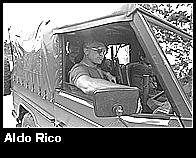 Luitenant Colonel Aldo Rico, Colonel Mohamed
Alí Seineldín and their clique came to be known
as the "Carapintadas" (painted faces) since they had their faces
smeared with bitumen. The Carapintadas were defeated by the legitimate
army forces, tried, and sentenced to prison.
Luitenant Colonel Aldo Rico, Colonel Mohamed
Alí Seineldín and their clique came to be known
as the "Carapintadas" (painted faces) since they had their faces
smeared with bitumen. The Carapintadas were defeated by the legitimate
army forces, tried, and sentenced to prison.
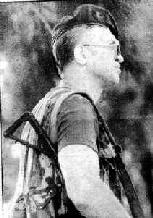 On October 5, 1989 as part of a sweeping military appeasement policy,
the newly elected president, Carlos Menem, pardoned most
of the convicted Carapintadas, Aldo Rico included.
On October 5, 1989 as part of a sweeping military appeasement policy,
the newly elected president, Carlos Menem, pardoned most
of the convicted Carapintadas, Aldo Rico included.
No longer in military service and out of prison, Aldo Rico turned to politics: In 1991, he established an ultra right-winged party called MODIN (Spanish initials for "Dignity and Independence Political Party",) which captured 10 percent of the national vote in late 1993, but was down to 1.8% of the votes in the elections for presidency in 1995. Responding to this defeat, in his trademark blunt style, Rico told journalists "If we made some mistakes I'm not going to talk about it to you."
Riveros, Santiago Omar (Gen.)
- While the diabolical machine of the junta repression was driven
by sadists and greedy petty officers and militiamen, the orders
nevertheless came from the highest ranks of the army.
As the head of the Argentine delegation, General Riveros
made the responsibility of the top-level for the crimes clear
in his fairwell speech given to the Inter-American Defence Junta
on January 24th, 1980:
"We waged this war with our doctrine in our hands, with the written
orders of each high command."
Riveros was sentenced to prison in the second series of trials against top military officers, but was set free after serving only a small part of his sentence as a result of military pressure.
Roualdes, Roberto Leopoldo (Col.)
- [New data received in July 1999]
As the commander of a special army commando in the province of
Entre Rios, participated in anti guerrilla actions
in the town of Victoria. After the 1976 coup, he was
promoted to colonel and moved to the capital Buenos Aires as
a deputy for the notorious General Suarez Mason,
head of the 1st Army corps where he served as commander
of the capital district commando. During his post in the capital,
Roberto Roualdes became richer, alledgedly due to the typical
seizure of property of disappeared people.
From an email to The Vanished Gallery:
``RLR had a boat. It was his most precious possession. Once promoted to colonel, he promptly moved to a bigger house. Then he had two houses. Then he exchanged his boat for a really fancy yacht. Things were going pretty well for him in those years when thousands were being shot and tortured within his district, it seems... RLR used to have phrases he liked repeating, one his favorites was "I'm the master of life and death" ...''
[source name withheld by request.] Rovere, Jorge Carlos Oliviera (Gen.)
- data requested
Ruben, O. Franco (Adm.)
- data requested
Ruiz, Julio C. (Brig.)
- data requested
Saint Jean, Ibérico (Gen.)
- Appointed governor of the Buenos Aires province
by the 1st junta. Appointed minister of the interior
by the 3rd (Galtieri) Junta. As late as June 1982
(after the mass disappearances were a well and widely known
fact) still blandly restated the false government line:
"out of 8700 persons arrested since the 1976 coup, 7000
had been released and a mere 475 remained in prison."
In the book Children of Cain by Tina Rosenberg General Saint Jean is quoted as saying:
"First, we must kill all subversives, then their sympathizers; then those who are indifferent; and finally, we must kill all those who are timid." Santamaria, Pedro A. (Rear Adm.)
- data requested
Santiago, Humberto F. (Brig.)
- data requested
Sasiaiñ, Juan Bautista. (Maj. Gen.)
- Commander of Campo de la Ribera, an originally military prison
turned secret detention center for civilians in Cordoba.
Served directly under Luciano Menendez.
Responsible for tortures an killings in that camp including
the well documented [file no. 4317] death of a woman, Amelia Nelida
Inzaurralde, as a result of torture.
Later, the head of the Argentine federal police. In an interview
to the paper La nacion on April 10, 1976, Sasiain declared
that "The army values a human being because the army is Christian."
One of the many examples how white, right-wing, nationalistic,
and religious sentiments had lead to the uncontrolled prosecution
of those who were different in any respect.
Sasiain was sentenced to prison in the second series of trials against top military officers, but was set free after serving only a small part of his sentence as a result of military pressure.
Scilingo, Adolfo Francisco (Navy Capt.)
- Almost twenty years after the junta atrocities took place retired Navy Captain Adolfo Scilingo broke the two decades of silence with a shocking confession. According to Scilingo, prisoners were stripped, drugged and thrown into the Atlantic from navy aircraft between 1976 and 1978. The full story as it appeared in TIME magazine. Scilingo's confession was soon followed by others like Sergeant Victor Ibanez,
Simon, Hector Julio (1st Sergeant)
- Also known as "The Turk", "Julian the Turk" (El Turco Julian
in Spanish). Although not a commissioned officer,
strong evidence against this extreme sadist
warrants the inclusion of his name here.
A member of the federal police in Buenos Aires. Chief torturer of prisoners in the secret detention centers Club Atletico, El Banco, and El Olimpo. A self-declared anti-semitic, used to wear a swastika on his chest, and loudly play records of Hitler speeches to his victims while shouting at them, punching them, and whipping them. One evidence mentions him kidnapping a man from a hospital after the man has been hit by a car.
Hector Julio Simon was spared indictment due to the "obedience of orders by low-ranking officials" clause. When interviewed on Argentine TV in 1995, he has made it clear that he has no regrets whatsoever, and if he would just be given the opportunity, he would do it all over again.
Seineldín, Mohamed Alí. (Col.)
- A co-leader of the extreme Carapintadas military group
who led a series of barrack uprisings
against the democratic government of Alfonsín in 1987 and 1988,
effectively blocking the judicial process against the responsible
for the 1976-1983 repression.
Unlike Luitenant Colonel Aldo Rico, and others who abandoned the violent struggle in favor of politics, Colonel Seineldín is the only one to remain in prison (as of Jan 1996). However his imprisonment is related to the uprising in the military base of Villa Martelli in 1988, and the December 3rd 1990 Operación Virgen de Luján and not for his part in the repression.
Seineldín is considered one of the most extreme of the extremists. He initiated clandestine training of a non-military militia group "Dignity Batallion", one of its members was quoted as saying: "In the world we admire Khaddafy and Noriega. The principal enemy is not Russia because Marxism is dying. The principal enemy, not counting Zionism, is the United States and England." [Norden: p. 145] Frequently seen with a large crucifix adorning his chest, Seineldín is known to be strongly antisemitic. "It's easier to find a green dog than an honest jew," he was quoted as saying during the "carapintada" revolt of Villa Martelli in 1988. During the same rebellion, one journalist, observed Seineldín wearing an arm band fabricated of the Argentine flag with a cross in the center. When asked about it, the colonel reportedly responded: "This? ... It's the next Argentine flag." [Norden: p. 132]. It should be noted that Jews suffered disproportionally and subjected to especially sadistic tortures under the dictatorship. While less than 1% of the Argentine population is jewish, more than 10% (some sources quote 13%) of the disappeared were jews.
Sotera, Alfredo (Brig.)
- data requested
Suárez Masón, Carlos Guillermo (Gen.)
- Alias Pajarito (Birdie) and El Cacique.
Commander of the 1st Army corps based in the capital of Buenos Aires
& suburbs. Known as "The Butcher of Olimpo" after the secret
detention center he was head of.
One of the leading figures in the most extreme faction in the
military during the repression era (together
with General Luciano Benjamin Menendez
and Colonel Mohamed Alí Seineldín.)
Escaped Argentina before the trials against top junta leaders
began. Found hiding in California in 1987 and extradited
to face trial. Convicted for crimes against the people but released
on October 1989 by president Menem after serving only a small part
of his sentence due to military pressure..
2000: Found guilty by an Italian court and sentenced in absentia for life for murdering eight Italians. Also wanted in Germany over the murder of a German student, Elisabeth Kaesemann, who was kidnapped in Argentina in 1977, during the the dictatorship.
June 2003: Found guilty and jailed for 2.5 years for racial discrimination in Argentine court at the age of 78. Federal Judge Norberto Oyarbide sentenced Suarez Mason: "For having justified the crime, for having made an exaltation of the torture and of the activity that developed in the last genocidal dictatorship that terrorised the country and for the discrimination in the Jewish community."
At the time of his sentence the ex-general was under house arrest in Buenos Aires on charges of kidnapping children during the dirty war.
It is estimated that about 300 children were taken from their mothers and given to the families of army and police personnel for adoption after the babies' parents were killed.
Suppicich, Jose M. (Rear Adm.)
- data requested
Trotz, Ernesto (Gen.)
- data requested
Valin, Alberto A. (Brig.)
- data requested
Verdura, Ignacio Anibal. (Lieut. Col.)
- Chief of the 2nd regiment of Armored Fusiliers of Olavarría. Responsible for the Monte Peone, La Huerta, Las Flores Detective Squad, and La Plata Detective Squad secret detention centers, located in the 124 security area, and hundreds of disappearances of persons who passed through them.
Verplaetsen, Fernando Ezequiel. (Gen.)
- Chief of Intelligence in Military Institutes in 1976. Chief of police of the Buenos Aires province in 1977. Responsible for setting up the secret detention center "El Campito" (aka "Los Tordos").
Videla, Jorge Rafael (Gen.)
-
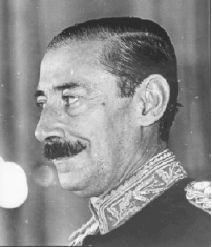 A.k.a. "The Bone." The head of the responsible.
A.k.a. "The Bone." The head of the responsible.
Born in Aug. 2, 1925, in Mercedes, Argentina de-facto president of Argentina from 1976 to 1981 and the main architect of the dirty-war.In 1975 President Isabel Perón, under pressure from the military establishment, appointed him commander in chief of the Argentinan Army. From this position he began a reorganization of the military leadership, removing officers sympathetic to Peronism. In the same year, he led an army campaign against the People's Revolutionary Army (Ejército Revolucionario del Pueblo or ERP) in the northern Tucumán province, which resulted in the annihilation of hundreds of leftist guerrillas. He proceeded to depose Isabel Perón
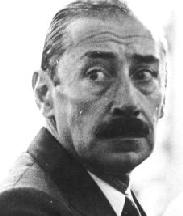 on March 24, 1976, and became the de-facto president as head of a three-man
military junta (the other two being: Air-Force commander
General Orlando Ramón Agosti,
and Navy Commander Admiral Eduardo Emilio Massera.)
on March 24, 1976, and became the de-facto president as head of a three-man
military junta (the other two being: Air-Force commander
General Orlando Ramón Agosti,
and Navy Commander Admiral Eduardo Emilio Massera.)
Videla then suspended Congress and vested legislative powers in a nine-man military commission, halted the functioning of the courts, political parties, and labor unions, imposed tight censorship on the mass-media, and filled all important posts with military personnel. Hundreds of persons suspected of being left-wing guerrillas were arrested in the last week of March 1976 alone, and between 10,000 and 30,000 others "disappeared" over the next few years.
Videla retired in 1981 and was succeeded by Roberto Viola.
Asked in 1977 about a woman who was in a wheelchair when she was captured by the military, General Videla replied, "One becomes a terrorist not only by killing with a weapon or setting a bomb but also by encouraging others through ideas that go against our Western and Christian civilization." [Children of Cain, p. 112]
On December 9, 1985, a civil court handed down its opinion, hundreds of pages long, convicting 5 of the nine members of the three preceeding military juntas. Videla and Massera who had commanded the army and navy during the worst years of the repression were convicted of multiple cases of homicide aggravated by the defenseless state of victims, aggravated false arrests, torture, torture resulting in death, and robbery, and sentenced to life imprisonment. However, both were released after serving only 4 years of their sentence as a result of military pressure.
Vilas, Acdel Edgardo (Gen.)
- Head of the detention center Escuelita de Famailla, in the
northern Tucuman province. Responsible for summary executions
of prisoners in the detention center and staged shootouts masked
as "confrontations" in Bahía Blanca and La Plata, by
the 5th army corps.
Sentenced to prison in the second series of trials against top military officers, but was set free after serving only a small part of his sentence as a result of military pressure.
Viola, Roberto Eduardo (Gen.)
- Succeeded Videla as president On March 29 1981.
Nine months later, on Dec. 21, 1981, the de-facto government announced
that Viola was stepping down for reasons of health, and General
Leopoldo Galtieri took the post.
When asked by a journalist about the need for an investigation into the problem of the disappeared, Viola replied: "that is absolutely out of the question. This is a war, and we are the winners. You can be certain that in the last war, if the armies of the Reich had won, the war crimes trials would have taken place in Virginia, not in Nuremberg." [Clarin, March 18, 1981] Sentenced to 17 years in prison by a civilian court on December 9, 1985. Released after serving only 4 years of the sentence as a result of military pressure.
Zaratiegui, Horacio (Rear Adm.)
- data requested
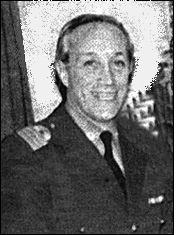
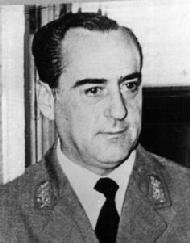

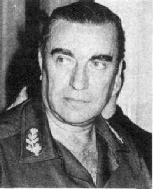
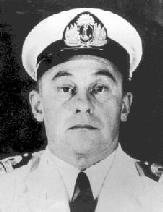


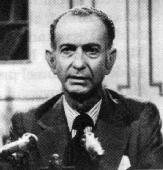



![]()
![]()
![]()
![]()
![]()
[Previous] . . .
[Next] . . .
[Up] . . .
[Home] . . .
[TOC+Search]
![]()


